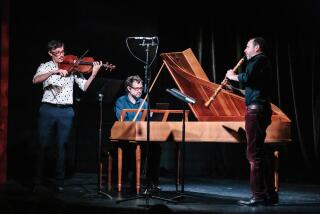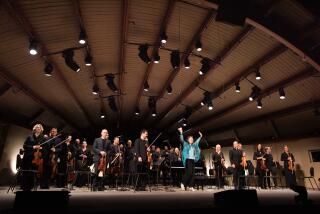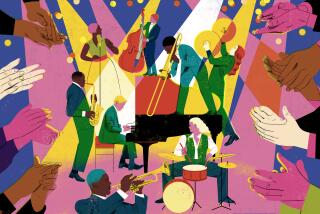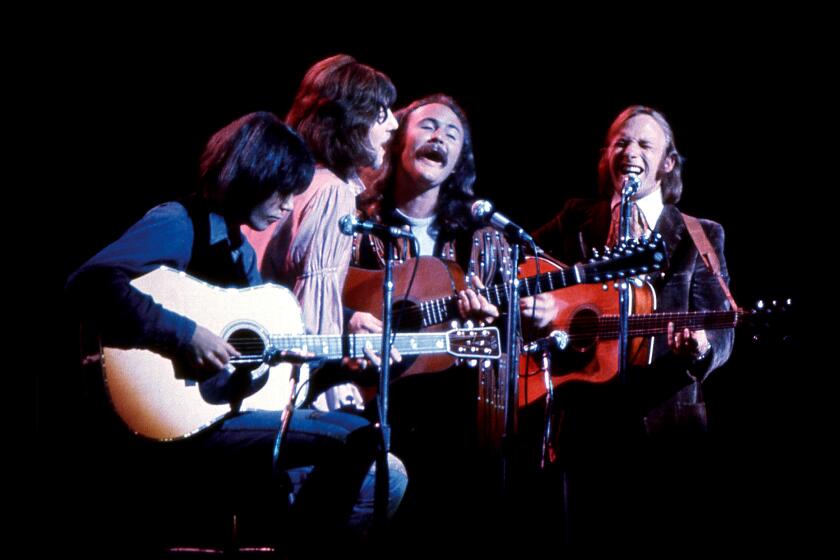JAZZ REVIEW : Turre, Akiyoshi: A Unique Merger
- Share via
COSTA MESA — There was a harmonic convergence of a musical sort Friday at the Orange County Performing Arts Center when trombonist Steve Turre’s 10-piece ensemble Sanctified Shells split the bill with the 16-piece Toshiko Akiyoshi Jazz Orchestra.
Though the makeup of the groups differs radically--Turre’s ensemble employs five trombonists who double on variously sized conch shells, while Akiyoshi’s outfit utilizes traditional big band instrumentation--both filled the evening with inventive, often unexpected sound combinations. The concert seemed to illustrate that, whatever the instrumentation, there are wide worlds of harmony out there waiting to be explored.
The unusual instrumentation of Turre’s Sanctified Shells made for surprisingly soothing sonic blends. Turre, whose most visible role is as trombonist for the Saturday Night Live band, started playing seashells in the late ‘60s as a member of Rahssan Roland Kirk’s band and continued to use them during his distinguished stint with the late Woody Shaw.
For his own band, Turre has arranged music for as many as seven shells (he often played two at once) as well as for various combinations of shells and trombones, while supplementing the traditional rhythm section with congas and an African drummer. A conch chorus often supplied background riffs above the Latin, African and hybrid beats. The result was a particularly warm blend of tones that could be vivacious one moment, haunting the next.
The actual playing of the shells--some as long as a man’s arm, others small enough to disappear inside a fist--made for fascinating visuals. Blowing into holes drilled in the shell’s tightly spiraled ends, the players continually pumped fists and cupped hands over the mouths of the shells, often with a boxer’s intensity. Because of their narrow range, one shell would rapidly be exchanged for another--without a break in the rhythmic flow. The resulting sounds, especially when played in harmony, could be hoots, purrs or mellow whistles.
There’s a danger in exploiting the novelty of the group’s makeup, but Turre’s material avoided that trap. Working entirely from his recent “Sanctified Shells” recording, the company opened with a six-shell fanfare in tones that recalled a quintet of French horns before moving into more rhythmic fare.
The leader’s “Toreador,” which featured trumpeter Charlie Sepulveda, has its roots in the Miles Davis-Gil Evans “Sketches of Spain” collaboration. “Gumbo” built on a shell-played shuffle that framed Clifton Anderson’s huff-and-puff trombone solo before Turre took a lively shout chorus on two differently pitched shells.
While shells define the band’s identity, the group also serves as a trombone choir, featuring many of current generation’s best slide practitioners (Anderson has been a member of Sonny Rollins’ band for several years while bass trombonist Clark Gayton tours with Illinois Jacquet). Jimmy Bosch took a clean-cut trombone improvisation during a percussive heavy number dedicated to the Afro-Cuban bandleader Machito, while Jamal Hanes blew up a blustery storm during “Gumbo.” Turre showed his strong, confident style both muted and open during “Toreador.”
The group’s percussive base was especially strong with Carlos (Potato) Valdez pounding up conga heat against drummer Adam Cruz’s counterpointed timekeeping. African percussionist Kweyao was the most expressive member of the section, adding a variety of tones from his squat djimbe drum during a number appropriately titled “Strength.”
While the orchestration of Akiyoshi’s aggregation was more familiar, it wasn’t any less inventive in its harmonic balances. The mix alternated among saxes, flutes, clarinets, trumpets, trombones and occasionally piccolo, creating a shifting pattern of color and emotion.
The leader’s “I Know Who Loves You” was typical, with a smart, introductory brass theme that introduced her sometimes dissonant piano lines. As she continued to unwind her quirky statement, the flutes began to rise from behind before trumpet and trombones signaled a fluidly melodic alto sax solo from Jerry Dodgion.
Akiyoshi’s genius also lies in her ability to combine the Eastern influences of her native Japan with the strong swing of Western jazz. “Sumi,” titled after the Japanese traditional painting form, was the best example of this with flutes suggesting Far East themes that were echoed by muted trumpets. Lew Tabackin’s flute solo swelled with the kind of overtones and dynamic swings associated with the Japanese shakuhachi flute. Though primarily known as a saxophonist, Tabackin is a top-shelf flutist and delivered a tremendously impressive performance during “Autumn Sea” that was rich with fleet, lengthy lines and agile octave leaps.
Tabackin took to his feet for “Chasing After Love,” sometimes stomping and scooting ahead while he maneuvered his tenor through statements of endless length and quality. Other fine solo work came from trombonists Conrad Herwig and Bruce Fowler, saxophonist David Glasser and baritonist Dan Block.
Despite or maybe because of comparisons of her work to the suites of Duke Ellington, Akiyoshi chose not to play one of her own ambitious ensemble pieces, such as the “Kourakan Suite” heard on her recent live recording from Carnegie Hall. Maybe time just didn’t allow for it. But considering the concert hall setting, it would have been most appropriate.
More to Read
The biggest entertainment stories
Get our big stories about Hollywood, film, television, music, arts, culture and more right in your inbox as soon as they publish.
You may occasionally receive promotional content from the Los Angeles Times.










